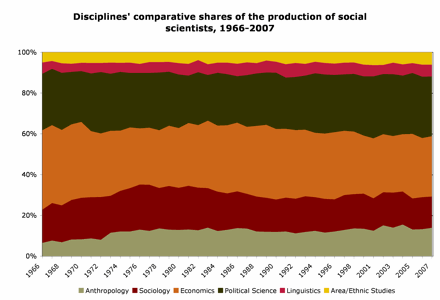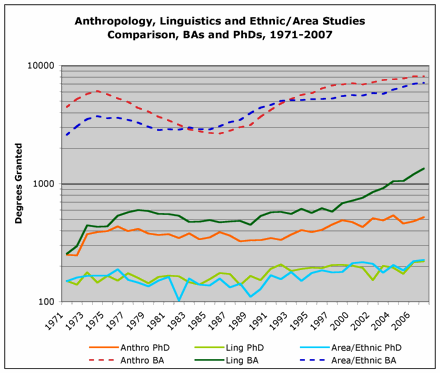Yesterday I considered the fact that, in terms of its production of undergrad degrees, anthropology is relatively small and about the same size as ethnic studies, with sociology and economics far above, and political science (cum-public-administration) far still above that.
But things look a bit different if we turn to look not at undergraduate degrees but at the doctoral degree production that’s essential for the reproduction of the teaching and research body of the profession. (Haven’t had time to look at Master’s degrees so far; I suppose that master’s degrees would serve a joint role as both an intermediate academic credential and a semi-professional credential, and are a stepping stone to the doctorate in some cases, but this requires more research.)

At the doctoral level, anthropology is no longer at the bottom of the charts; over the past forty years it has climbed from being one of the smallest social science graduate fields to being roughly similar to sociology. In 2007, anthro graduated 519 new PhDs while sociology was at 573. Economics, nonetheless, clearly appears to be the dominant social science discipline (demographically speaking), though political science has approached it on several occasions and even surpassed it for a few years earlier this decade.
An interesting thing, in passing, is that some of the small dips and rises in these fields seem to be matched across fields — the little dip around 2002, for example — which suggests that some of these shifts may be results of larger institution-wide changes, and not always discipline-specific; there might be, for example, global reductions in student intake. It certainly sounds plausible.
We do see clearly that the two small, relatively “dominated” fields here are linguistics and ethnic/area studies. They appear not only to be small but also to have stayed relatively static in size over the last few decades — while the other disciplines have seen what looks like more of an upward swing since the 80s. We can see their relatively tiny share even more clearly if we examine a graph of comparative shares of social science doctorates produced over time.

Anthropology, shown at the bottom of the graph, has actually grown in comparative importance since the 60s – it produced 6.3% of social science doctorates in 1966, but is now up to 13.8% (in 2007). Political science and economics loom large in the center of the graph (currently producing a 58.9% majority of all of social science doctorates). It crosses my mind that economics PhDs may have more non-academic job possibilities, meaning that its comparatively larger production of scholars may indicate not a proportionately large academic job market but only that a lot of economics PhDs are getting jobs in government or the private sector. According to CIRGE, who surveyed social science PhDs five years out of grad school, about 18% of social scientists overall worked outside academia; they left economics out of their survey, though, where the percentage may be higher. At my university, 49% of economics PhDs get jobs outside academia, but that may be on the high side of things.
As you can see here as clearly as before, area/ethnic studies and linguistics are small slivers of the total production (at the top of the graph). It’s interesting, however, to compare their situations at the doctoral level with their situations at the bachelor’s level. At the bachelor’s level, linguistics is tiny while anthro and ethnic/area studies are somewhat larger, whereas at the doctoral level, linguistics and area/ethnic studies are both tiny while anthropology remains somewhat larger. In other words, area/ethnic studies is comparatively much larger at the BA level than at the PhD level. Consider the following.

This graph compares the number of BAs to the number of PhDs produced across these three fields. Basically, in comparison to anthropology, it seems that there are way more ethnic/area studies undergrads getting degrees than there are ethnic studies PhDs being produced. My guess is that ethnic/area studies are relatively popular undergraduate fields, but that many people teaching in such fields originally get their PhDs in a more traditional discipline (like anthropology, history, etc), so we see a relative disproportion between the output of scholars (PhDs) and the output of students (BAs).
(I had to plot this on a logarithmic scale because otherwise it would be impossible to show the anthro and ethnic/area studies BAs and PhDs on the same graph; since the PhDs are around an order of magnitude less, they would vanish into the bottom of the scale if it were linear.)
I thought about this last comparison some more and, just for another point of reference, put together one more curious graph, which I’m honestly not quite sure how to interpret yet.

This is a graph of the number of BAs to the number of PhDs for a given year, across fields. OK, so, lower means that fewer BAs are awarded per PhD. In essence, it’s a student:teacher production ratio. It could also, leaving aside inter-field migrations like the (probable) crossover between anthropology and area studies mentioned above, be taken as an index of how research-oriented a given field is; lower means that the field is relatively more oriented towards the production of new scholars, higher means that the field is relatively more oriented towards the production of new bachelor’s holders.
As you see, linguistics is the lowest — they have relatively few undergraduate majors compared to the number of new linguists they produce at the doctoral level. Anthropology is pretty consistently second lowest in this regard. Sociology and political science produce the most BAs per PhD; economics is sort of in the middle, and ethnic/area studies has been climbing, which suggests that their undergrad production is growing at a faster rate than their graduate production.
I will confess, it’s strange to think about these quantitative dimensions of the “production of scholars”; I don’t experience graduate school as being like an assembly line where you come out the end as a figure in a large spreadsheet. Though, of course, that sense is itself revealing of the fact that graduate students are valued for being different from each other, within given disciplinary boundaries. You could say that we’re mass-produced to have fantasies of individuality.
Now, I have to add that at an experiential or practical level, it’s not clear that these disproportions between the number of new economists and the number of new anthropologists make a huge difference. I virtually never interact with economists, so it would seem to make almost no difference how many of them there are; the disciplinary barrier between us is practically impenetrable. Disciplines’ statuses in academia is in some ways more like the US Senate than the House of Representatives: to get by in many contexts, it suffices just to have a discipline, and more power doesn’t necessarily accrue to the largest ones simply by virtue of their size. Still, it’s easy to imagine that institutional resources are distributed in some relation to the size of the disciplines. Larger disciplines = more office space, more faculty salaries, more facilities… not that these resources are always allocated in direct proportion to departmental size: on our campus, they recently announced a $100 million Milton Friedman Institute for Research in Economics, and the very same day they also inaugurated a $0 million dollar Edward Sapir Anthropological Research Center, along with a $0 million dollar Robert Park Sociology Institute and a $0 million dollar… well, you get my drift.
There seem to be complicated, bidirectional relations between the success of a department and its treatment by its administration. Are large departments well funded because they’re large, or are they large because they’re well funded? On our campus, for example, I believe that the size of incoming graduate student classes is determined substantially by higher administrators, who allocate slots for incoming students. They consult with the departments about how to allocate resources, but they also control the money and therefore tend to have the power, in the end. So it seems worthwhile asking ourselves the Marc Bousquet question here: to what extent should we be analyzing the relative size of the disciplines not as an independent phenomenon but as a result of higher layers of administrative decision-making?
Coming up, I’m going to take a closer look at graduate funding and departmental dominance within anthropology itself.
I don’t think that its particularly helpful to refer to administrators’ tastes in explaining the relative size of academic disciplines. They are trying to secure, federal and private sources of funding, satisfy undergraduates and secure their tuition, satisfy current faculty. To an under-appreciated extent, the desire for prestige drives the preferences of undergraduates, graduates, faculty, administrators, board members, etc. This deserves more analysis.
I didn’t mean to say anything about “tastes” or, for that matter, administrators’ thought processes in general. My comment was meant to be simply about the direction of causality between disciplinary size and administrative decision-making. Yes, of course there are various ways of analyzing the processes by which these decisions get made, some of which would have to do with taste or personal pique, some with money, some with (ill-defined and problematic) ideas about prestige… certainly prestige matters, but I think attempted prestige maximization is but one of many important causal factors and not a kind of central lynchpin of the system. How would you go about doing more analysis of this, though?